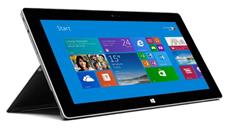Tablets are the curious, in-between, middle ground of computing technology. Papa Bear can be the desktop or laptop--Too hot! Mama Bear can be the smart phone--Too cold! Our protagonist, Baby Bear is that ‘just right’ tablet. Tablets are a wonderful compromise of size, portability, and power; and as a result, tablet ownership, especially in education, has never been more popular. They are becoming a classroom accommodation that offers learning potential not just in school, but as tools at home.
 A Pew Research Center study conducted in October 2013 computed that the number of Americans ages 16 and older who own tablet computers has grown to 35%. Overall, roughly 110,000,000 currently own a tablet in America--a number that is larger than the percentage of the same American population who tuned in for Super Bowl last year.
A Pew Research Center study conducted in October 2013 computed that the number of Americans ages 16 and older who own tablet computers has grown to 35%. Overall, roughly 110,000,000 currently own a tablet in America--a number that is larger than the percentage of the same American population who tuned in for Super Bowl last year.
Nearly 20% of Americans, or almost 60 million people, identify as having a disability. Of that number, 2.8 million are students. Within a growing number of Americans utilizing a tablet, people, and specifically young students, with disabilities cannot be overlooked.
Seemingly a flat device with limited tactile features, the sheer appearance screams inaccessibility. Some folks ask in curiosity—if a student can’t see or feel a tablet, how could they use it?  The features that our tablets possess are evolving quickly. Yet, the definition of a tablet has not, so when it is stripped down to its essentials, we are left with a handheld, touchscreen device. Within this identity, some might argue that certain accessibility features are one part of the bigger design. However, I respectfully disagree: accessibility is the design. Tablets are only as good as their potential to be used.
The features that our tablets possess are evolving quickly. Yet, the definition of a tablet has not, so when it is stripped down to its essentials, we are left with a handheld, touchscreen device. Within this identity, some might argue that certain accessibility features are one part of the bigger design. However, I respectfully disagree: accessibility is the design. Tablets are only as good as their potential to be used.
I set out on a journey of my own—to personally use features that enable access by students with disabilities. Turns out, I had a couple of things to learn myself!
(Read more in part 2 next week.)
 15
15 
